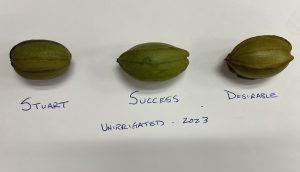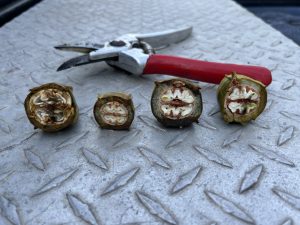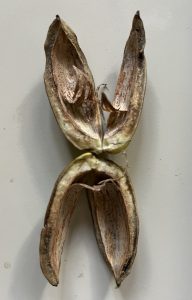Functionality & Vitality of Pecan Tree Organs: The Fruit
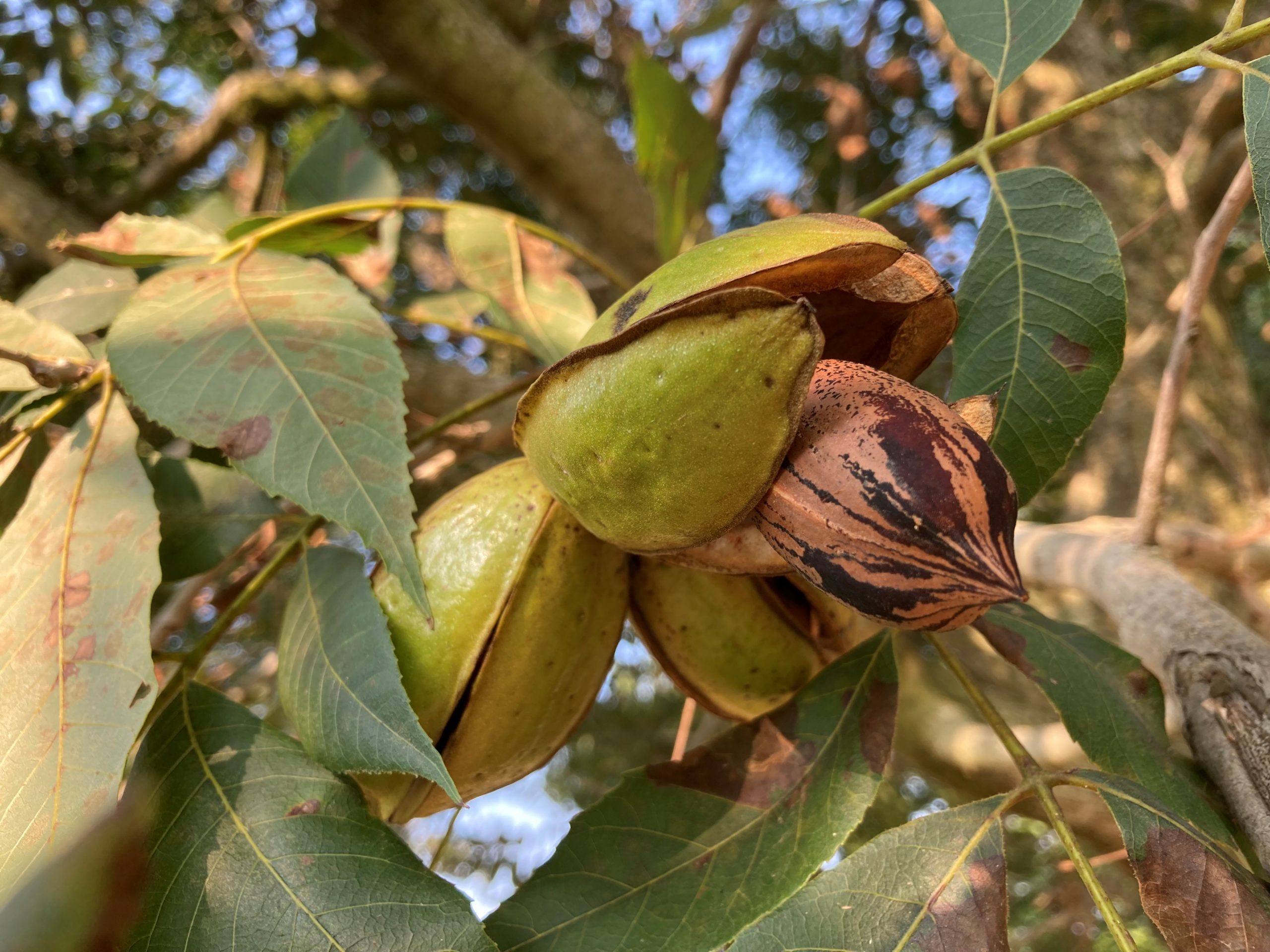
Shuck split in pecan plainly then likens the species more to a drupe than true nut. (Photo by Monte Nesbitt)
A pecan tree has six organs—defined as collections of tissues that work together to perform an essential purpose. Three organs support the living tree—roots, leaves, and stems. They are in no way as fragile as a human heart, but the tree itself is vulnerable. It’s a stationary being imposed upon by a wide array of weather and biology. Only by procreating more trees does it preserve itself, and three organs are responsible for that survival—flower, fruit, and seed.
The pecan is a member of a major division of plant types called “angiosperms,” seed-producing plants whose seeds are borne in plant organs we call fruit. Fruit comes in a myriad of forms: simple tiny berries to quite large pumpkins, jackfruit, and coconuts. Some are colorful and attractive to the eye, and others are inconspicuous. Some are poisonous to people, but many are edible. Across all this fruit diversity is one common purpose: growing, nurturing, and dispersing seed to perpetuate the species. Fruit is essentially nature’s own SherpaPak. It’s a transient vessel needed for a limited period to ensure the life of the seed organ that it carries.
October ushers in the pecan harvest season in the southern U.S. Trunk shakers, harvesters, and cleaners are brought to bear on separating two of the six organs of a pecan tree—fruit and seed. The seed crop’s quantity and quality determine the pecan industry’s financial success. The buck stops with the edible portion. How much kernel is present and how large the kernel halves are directly impacts the bottom line. Every pair of kernel halves was grown by one fruit, whose functionality and vitality over a 200-day growing season was very important. At this juncture of assessing kernel quality while discarding shucks into piles of debris, let’s study the fruit thoroughly and consider how we got here.
Form (Morphology & Anatomy)
From the perspectives of culinary usage and commercial agriculture industries, pecan is considered a nut or, more specifically, a “tree nut.” From the perspective of botany, pecan is a fruit tree (angiosperm) whose fruit is best classified as a drupe, pseudodrupe, or drupaceous nut rather than a proper nut. Drupes and nuts are subclassifications of fruit botanists make to distinguish anatomical features. These classifications have changed over time, with different botanists debating fine details on the anatomy and terminology around “nuts” so much that some have even suggested dropping the term altogether (Spjut, 1994). Drupes and true nuts both have a single, hard-shelled seed. Drupes have protective layers of pericarpal tissue over the seed that naturally dehisce (open) once the seed has matured. True nuts do not dehisce to release the seed. Shuck split in pecan then plainly likens the species more to a drupe than a true nut.
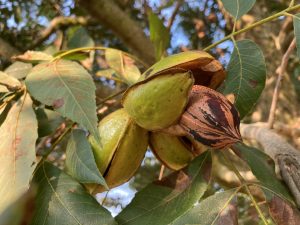
Shuck split in pecan plainly then likens the species more to a drupe than true nut. (Photo by Monte Nesbitt)
Peach, cherry, and olive are examples of drupes with edible pericarp. Pistachio, almond, coconut, and pecan are examples of drupes, having inedible and discarded pericarp. Oak acorns, hazelnuts, and chestnuts are examples of true “nuts.”
What ultimately develops into the pecan drupe begins as the female (pistillate) flower, often called a “nutlet.” (It might be better described in the future as a “drupelet”?) Pistillate flowers emerge in the unfolding leaves of terminal stem buds soon after budbreak. They are sessile (attached by their base with no individual stalk) on a central stalk called a peduncle. They have a small, bulb-shaped perianth with four faint, longitudinal ridges. The perianth is capped with the stigma, the surface of which ranges in color from green to gold to pink and is textured, turning brown with age. When receptive to pollen, the stigma will be more tactile and capable of sticking pollen to it. Beneath the stigma is a short, tubular style through which a pollen tube grows for contacting and fertilizing the egg housed in the dicarpel ovary pouch or “sac.”
If pollination is successful with all the drupelets in a spike, they become a cluster of two to five nuts typically. Higher numbers of nuts per cluster may sometimes be observed on heavy-bearing varieties. Successful fertilization of a female nutlet is first indicated by lack of any dropping out/abortion of flowers, usually expected five to six weeks after the flower receptivity period ends. Flower spikes may start with four to five nutlets and pare down to two, one, or none if pollination conditions were poor or other factors cause stress drop. The second indicator of successful pollination and fertilization is the enlargement of the nutlet, which from that point forward is considered a fruit rather than a flower.
Two processes are at work internally in a pecan fruit from the point of fertilization onward. After growing its way to the termination of the style, the pollen tube that germinates when pollination happens forms two sperm cells. One merges with the egg cell in the ovary to form the zygote (new genetic individual), and the other links with the binucleate central cell, forming a primary endosperm cell that forms endosperm tissue. So, one pecan “fruit,” “drupe,” or “drupaceous nut” is actually two organs developing simultaneously. The fertilized egg or “zygote” eventually becomes the pecan kernel or tree seed, while the endosperm is the nutrient and water-conducting mediator of the embryo’s development—the fruit.
Pecan fruit experiences dramatic morphological change during the growing season. The first 90 days are the “nut sizing phase.” Cell division and cell elongation happen at a logarithmic pace, increasing fruit volume by as much as 2,000% in some large-nut varieties. The endosperm begins as a white-colored, starchy mass of cells. It is a food and nutrient source that provides for the growth of the fruit and the embryo. Endosperm becomes liquid toward the end of the sizing period in early August. At the same time, the embryonic kernels grow and elongate from tip to base, forming two thin and delicate membranes that become the skin of each individual kernel.
As the fruit nears the end of the sizing phase, the outer cells of the embryo begin to lignify to form a seed coat, a process pecan growers call shell hardening. Starting at the blossom end of the fruit and working its way basipetally, the seed coat becomes a protective cover—the pecan shell. Its purpose is to prevent insect, fungal growth, or physical breakage that would jeopardize the kernel tissue’s ability to germinate and grow a seedling pecan tree after shuck split.
The hard pecan shell or seed coat delineates fruit tissues from seed. Below the seed coat, the fully extended kernel sacks fill with water (water stage), become gelatinous (gel stage), and then add thin layers of fat inwardly during the dough stage on its way to making two solid kernel halves. Above the seed coat, the drupaceous tissue of the shuck grows in thickness during the growing season as it takes up water and nutrients that keep it alive, turgid, and capable of transferring water and nutrients to the embryo. The outer surface of the shuck, which is analogous to the peel or skin of a peach, is called exocarp. Below that, like the flesh of a peach, is the mesocarp tissue, which, in the case of pecan, is anything but sweet.
Pecan exocarp is universally green in color, although varying wildly in hue by variety. At a distance, the shucks on most varieties appear glossy and smooth owing to the waxy cuticular cells not unlike those of leaves. Some varieties like ‘Lakota’ and ‘McMillan’ exhibit a duller, grainier, hickory shuck-like texture. Under magnification, pecan shucks are quite irregular with tiny bumps, creases, and pockets interspersed with stomata—yes, shucks transpire water and exchange carbon dioxide and oxygen like leaves. The pecan fruit’s outward appearance and shape are influenced by the shape, length, and size of the embryo’s shell. Fruit appearance is consistent by variety. ‘Desirable’ fruit looks different than ‘Stuart,’ which looks different from ‘Success,’ ‘Caddo,’ etc. The fruit’s size at a given location varies from year to year, as affected by soil moisture, crop load, and overall tree vigor.
Examined in cross-section, the healthy mesocarp is a whitish-colored, densely fibrous sponge. Contained within this mass are the xylem and phloem cells, laid down as continuous chains of cells from the stem end to the fruit apex, then turning and doubling back on itself and winding back to the base. Fan-shaped veins of these conductive cells spread out along the basal shell surface and serve as the lifelines nourishing the developing seed.
The shuck has four ridges extending from base to tip. They were evident at the female flowers’ first appearance and have grown proportionally during the fruit development. These ridges contain predetermined abscission zones that separate when the seed has matured and hormone levels shift to levels that signal the end of the fruit structure’s life. The abscission cracks and divides the carpel tissue into four uniform valves. Each valve has a connection at its base to the peduncle of the cluster and continues to receive moisture for a short time after shuck split, but another predetermined abscission layer breaks that connection, and the pecan fruit dies.
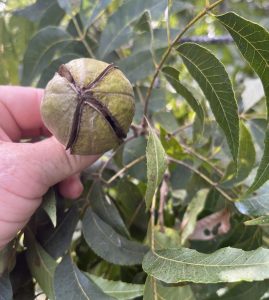
Shuck “ridges”-abscission layers that divide the carpel tissue into four “valves.” (Photo by Monte Nesbitt)
Function (Purpose & Contribution)
Plant fruit organs are analogous to a mother’s womb or placenta in animals and humans. They protect the fragile embryo from exposure to excessive heat, drying, and physical damage. They also provide three things embryonic kernels need: water, carbohydrates for energy and growth, and mineral nutrients. Healthy and thick shucks have been positively correlated with increased percent kernel and other quality indices (Thompson, 2005). Shuck thickness is believed to have both genetic and environmental/cultural components.
Calcote (1984) used dye and microscopy to show that pecan shucks have an elaborate vascular network for moving water into and around the shuck and seed. The xylem enters the base of the fruit via the peduncle from two opposing directions and then spreads outwardly in a network of veins just below the shuck surface, moving upward toward the fruit tip. The veins extend upward and outward, cross over the apex of the fruit, and then change direction, moving downward close to the shell surface to enter the developing seed near the base. They make an attachment to the embryo at the septum and seed coat. Remnants of these veins, commonly called “rag,” can be seen after shuck split on the base of the pecan shell and are the last attachment of the seed to the open and drying drupe. In addition to the internal translocation of water, the shuck transpires water from stomates and associated cuticle cells.
Mineral nutrients are similarly moved to the seed via the shuck’s xylem and phloem. What nutrients? All essential plant nutrients may play a role based on the timing of development. Wells and Wood (2008) analyzed the liquid endosperm of ‘Wichita’ pecans in mid-August in Georgia in studies of water stage split. They found the following relative percentages: potassium 69%, calcium 19%, magnesium 8%, phosphorus 4%, copper 0.3%, zinc 0.04%, manganese 0.01%, iron 0.01%, and molybdenum, nickel, boron, and sodium each less than 0.01%. Nitrogen, absent in the liquid endosperm, could be expected to be found in the carpel tissue, among other nutrients.
The carbohydrates needed to make high-quality kernels are translocated in the phloem vessels that network through the fruit much like the xylem. Some are also made by the photosynthetic action of the shuck tissue. How much photosynthesis the pecan fruit contributes has historically been believed to be low (less than 10%). Recently, though, Xu and co-investigators (2016) found that pecan fruit actually had higher gross photosynthetic rates on an area basis than leaves during fruit growth and seed development. At 110 to 123 days after pollination (mid to late August), they found fruit contributed 33% of their carbon requirement at that time. They also found leaf photosynthesis rates declining during that time of the season. These findings don’t change the fact that pecan fruits are carbohydrate “sinks.” They must receive carbohydrates from leaf photosynthesis. Marquard (1987) found that four compound leaves were adequate to develop ‘Mohawk,’ a large-fruited variety, and that additional carbohydrate production from the leaves would go to tree health and the growth of woody tissues. Xu et al.’s findings emphasize that the health of both leaves and shucks is a critical contributor to good fruit and seed development.
The pecan fruit adds important weight burden to the pecan canopy. The average fresh shuck weight of six diverse cultivars was 15.6 grams, compared to 9.8 grams of fresh nut weight, or 1.6 times heavier, a significant contributor to limb breakage if crops are too heavy (Thompson, 2005).
A function of shucks we haven’t yet learned how to take advantage of is their high phenolic compound content. Pecan orchard workers who handle many green shucks at harvest will have dark brown stains on their hands and clothing to show for it. Tannic acid, the cause of the staining, is one of those rich bioactive compounds that may assist in protecting the developing embryo, warding off insects, or overcoming injury.
Juglone is another phenolic in leaves and shucks of walnuts, hickories, and pecans. Juglone is a bioactive chemical believed to offer several benefits, from disease resistance to weed and nematode suppression. Juglone was studied in the early 1980s by Clinton Graves and coworkers in Mississippi who believed juglone offered answers to pecan scab resistance. Juglone is higher in walnut fruit than pecan and is known in both crops to attain its highest levels in fruit tissue at maturity.
Vitality (Requirements to Thrive)
Water is critical to fruit health. The shuck tissue of six varieties of pecans grown at Brownwood, Texas, had an average water content of 83.3%, an indicator of water’s importance to vitality and vigor (Thompson, 2005). Water stress during the nut sizing phase, May to August, will cause reductions in fruit size. Water stress during the kernel filling period, August to October, will cause direct loss of kernel mass and weight. The shuck itself may be impaired by water stress in the late season, either by induction of shuck dieback disorder or poor shuck opening caused by loss of turgidity.
Mineral nutrition is also essential to fruit development and function. Water stage split is a serious fruit disorder causing severe economic losses on certain predisposed varieties. I’ve personally observed ‘Cape Fear’ trees in Alabama lose approximately half their crop in the span of three days. Wells and Wood (2008) lessened the severity of water stage split by applying boron, nickel, or boron and nickel together in early spring. Other mineral deficiencies may limit fruit size, shuck thickness, and seed quality.
Except for ‘Desirable,’ which has been frequently observed to self-thin its crop, most pecan varieties overbear and alternate bear. They generally set and retain a fruit crop that requires more energy, nutrient distribution, and water than the tree can provide. Overcropped trees may exhibit several late-season shuck disorders, including vivipary (preharvest sprouting), shuck decline—a necrosis of the shuck that halts kernel development—and sticktights. Trees carrying more than 85% terminals with clusters, especially those with large-size fruit (‘Choctaw,’ ‘Kiowa,’ etc.), will experience shuck disorders unless crop load is lessened with crop load thinning, hedging, or both. Trying to irrigate and fertilize more typically does not help.
Pecan kernels are approximately 70% lipids—oil, a plant tissue that is energy-consumptive to make. With pecan shucks contributing an important amount of energy production themselves, it raises the importance of sunlight in the tree canopy. High leaf photosynthetic rates don’t happen in the shade. Pecan trees need abundant sunlight to create the carbohydrate production rates that support the growth and development of all growth and reproductive organs, including fruit.
Physical damage to fruit lowers its translocation, transpiration, and photosynthetic capacity. Pecan fruit damage comes in various forms: insects, fungal pathogens, bird pecks, and bruising in windstorms. The elaborate venation and complex routing of the xylem and phloem pathway, much like venation in leaves, provide a hedge against minor physical injury. There is no single point of water and nutrient entry into the fruit or the seed embryo, increasing the ability of the tree to produce viable seeds despite these threats. Yet, the best seed quality—the largest nut size and highest percent kernel—undoubtedly comes from undamaged fruit.
Management Implications
Soil Moisture Monitoring:
The 2023 growing season has been difficult for many pecan growers from the absence of precipitation for as much as 90 days in some places coupled with 100+ degree F temperatures almost every day in that same period. For orchards where well capacity was marginal, to begin with, or where water tables recede and water-well pumps stop operating, there is little that can be done by management except to watch the crop suffer and hope the trees don’t die. But where orchards have enough water, there is plenty of opportunity to try to make the most efficient use of water by scheduling. The irrigation run time per tree block is a critical management decision. Irrigation water can be harmful or at least wasted by delivering more water to a defined volume of soil than it can hold per unit of time.
Two things happen when irrigation run times are too long or the cycling between blocks is too short. First, the per acre rates of water are not as high as they should be because gravity is moving water beyond the depth it can be used effectively by roots. Second, oxygen levels in the rootzone decline to suboptimal, reducing root respiration and water uptake. Too much water and too little water have the same negative impact on trees. Roots suffer in both situations, causing leaves and fruit to suffer along with them.
Scheduling irrigation should come from an informed position. Growers should probe, excavate, feel the soil, install soil moisture sensing devices, use pressure chambers—everything they can to know whether their run times are helping or hurting. A starting point to be informed is identifying soil texture in the A and B horizons, along with knowing the water holding capacity of the soil in inches per inch. Both of these important pieces of information can be determined from soil samples or existing soil survey maps, like those readily available online from USDA-NRCS, Web Soil Survey – Home (usda.gov).
Leaf analysis:
Hidden hunger is a term used in plant nutrition to describe plant performance that is seemingly adequate outwardly when, in fact, physiological processes are being limited that result in growth reduction, lower yield, or quality loss. Correcting soil nutrient levels and increasing their availability to plants cannot always be done quickly. Some minerals require months after fertilization to become available to the tree. Growers must be concerned not only with the current crop but also with how nutrient depletion or over-accumulation may impact next year’s crop and beyond. Leaf analysis based on July sampling is presently the best diagnostic tool for evaluating pecan trees’ nutritional health. We know less about fruit nutrient levels at different points in the growing season and whether such measurements could be used for fertilizer recommendations and improvement in final kernel quality.
Crop Load Estimating & Thinning:
Orchard managers need to estimate their crop load accurately. It probably doesn’t matter when it’s evident that an orchard is experiencing an off year (light production), but at moderate to heavy yields, it’s important to know early in the season whether thinning the crop should be practiced. Preliminary crop estimates should be made during pecan nut casebearer (PNC) scouting in early May to know how much crop protection from that pest is needed. PNC can provide beneficial thinning, but the scouting and crop estimation both need to be thorough. From early July onward, counting and recording percent terminals with clusters can be considered accurate predictors of crop load. By that date, trees have passed the pollination drop, stress drop, and the PNC damage period.
The highest benefit to crop load thinning is obtained when removing the fruit prior to full embryo elongation or early shell hardening. Most southern pecan varieties begin to reach this stage from mid-July to early August, varying by variety. Fruit can be removed later than this time, and it will benefit the developing crop by reducing on-tree demand. The benefits to next year’s crop become minimal with increasing fruit development time on the tree.
Sunlight Evaluation:
The fact that the shucks themselves contribute as much as a third of their own needed photosynthetic energy production raises the stakes for pecan orchard sunlight management. Leaves and fruit both need high sunlight levels! A common misconception among pecan growers is that if the limbs are not touching, pecan trees have ample sunlight and are not overcrowded. The truth is that to achieve a 50:50 ratio of sun to shade on the orchard floor at midday (a common standard for adequate sunlight), the shadow cast by each tree must not exceed a certain size. For a 30-by-30-foot tree spacing, driplines of canopies should be at least 6 feet apart. For a 35-by-35-foot spacing, driplines should be 7 feet apart. Those distances or greater should be maintained by tree removal or hedging.
Integrated Pest Management:
The direct damage to pecan fruit by insects and diseases must be minimized with a well-planned and executed integrated pest management program (IPM). The number of problems attacking just the pecan fruit is less than for foliage, but they are serious threats that encompass the entire growing season. Pecan scab, stem-end blight, and Phytophthora shuck and kernel rot on the plant disease side create a need for season-long protective measures in humid areas. On the insect side, the main threats—PNC, pecan weevil, stinkbugs, leaffooted bugs, and hickory shuckworm—can be damaging over 150 days of the season; even yellow aphids must be viewed as an indirect pest of pecan fruit. They do not feed on the shuck, yet modest numbers of aphids on leaves deposit honeydew on both the leaves and shucks, causing sooty mold that reduces photosynthesis. Aphids are a significant pest in pecan IPM. Pecan orchard managers must stay engaged throughout the growing season—scouting, keeping records, and staying abreast of new products and control strategies.
Pecan is the army jeep of the fruit world. It is utilitarian, a drupe that’s neither flashy nor colorful to look at, blending in with the scenery of tree leaves. We look beyond the fruit, desiring instead to know what’s inside. Our prize is the seed. We get paid for the seeds. We win pecan shows with the seeds and make wonderful edible treats with the seeds. The pecan fruit is only the builder, protector, and courier of those seeds. After shuck-split, it exits quickly, and its troubles are easily forgotten. The functionality and vitality of the fruit though deserve credit for the prize.
References:
Calcote, V.R., R.E. Hunter, and T.E. Thompson. 1984. Nutrient flow through the pecan shuck into the nut and disruption of this flow by Hickory Shuckworm larvae. Proc Southeastern Pecan Growers Assoc. 77:61-70.
Marquard, R.D. 1987. Influence of leaf-to-fruit ratio on nut quality, shoot carbohydrates, and photosynthesis of pecan. HortScience 22:256-257.
Spjut, R.W. 1994. A systematic treatment of fruit types. Mem. New York Bot. Gard. 70:1-182.
Thompson, T.E. 2005. Pecan fruit shuck thickness is related to nut quality. HortScience. 40(6): 1664-1666.
Wells, M.L. and B.W. Wood. 2008. Foliar Boron and Nickel Applications Reduce Water-stage Fruit-split of Pecan HORTSCIENCE 43(5):1437–1440. 2008.
Xu, Q., J. Wu, Y. Cao, X. Yang, Z. Wang, J. Huang, G. Xia, Q. Zhang, and Y. Hu. 2016. Photosynthetic characteristics of leaves and fruit of Hickory and Pecan during fruit development stages. Trees 30:1523-1534.

